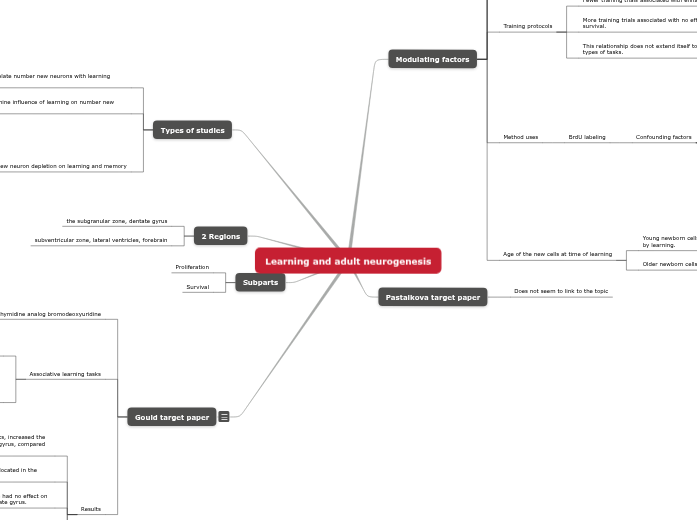Learning and adult neurogenesis
Modulating factors
Physical activity
increase proliferation
Enriched environment
Stress
decreases proliferation
Mouse specificities
strain
species
age
sex
Training protocols
Fewer training trials associated with enhanced cell survival.
More training trials associated with no effect or decreases in survival.
This relationship does not extend itself to training with all types of tasks.
Method uses
BrdU labeling
Confounding factors
Does also detect DNA repair
Changes in integrity blood brain barrier may influence number of cells labeled
Dilution of label due to cell division
Overestimation
Underestimation
Timing of the labelling
Timing should be immediately before or within hours after testing
Subjects should be treated with the tracer and killed within 24 hours (before end of complete cell cycle)
Age of the new cells at time of learning
Young newborn cells (1 week) survival seems to be enhanced by learning.
Older newborn cells survival seems to decrease by learning.
Pastalkova target paper
Does not seem to link to the topic
Types of studies
Studies that correlate number new neurons with learning abilities
Available evidence is incomplete and mixed. Both evidence for and against role neurogenesis in learning.
Studies that examine influence of learning on number new neurons
Mixed and incomplete evidence, due to lack of knowledge of mechanisms of these new cells and varying protocols.
Effect of new neuron depletion on learning and memory
Antimitotic drugs
Can induce nonspecific effects
Timing and duration of neuron depletion may be a critical factor in determining learning deficits.
irradiation
2 Regions
the subgranular zone, dentate gyrus
subventricular zone, lateral ventricles, forebrain
Subparts
Proliferation
Survival
Gould target paper
thymidine analog bromodeoxyuridine
Injected one week before training
Associative learning tasks
Hippocampus-dependent
Trace protocol eyeblink response conditioning
Spatial navigation learning Morris water maze
Hippocampus-independent
Delay protocol eyeblink response conditioning
Cue training Morris water maze
Results
Learning of the hippocampus-dependent tasks, increased the number of BrdU-labeled cells in the dentate gyrus, compared to naive controls.
The majority of new hippocampal cells were located in the granule cell layer
Exposure to similar environmental conditions had no effect on the number of BrdU-labeled cells in the dentate gyrus.
Likely that increased number of cells is caused by enhanced survival, not proliferation. = significant differences among groups of pyknotic cells in subgranular zone.
Effect on proliferation checked = BrdU injection during training. = No difference number of cells in conditioned animals and controls
